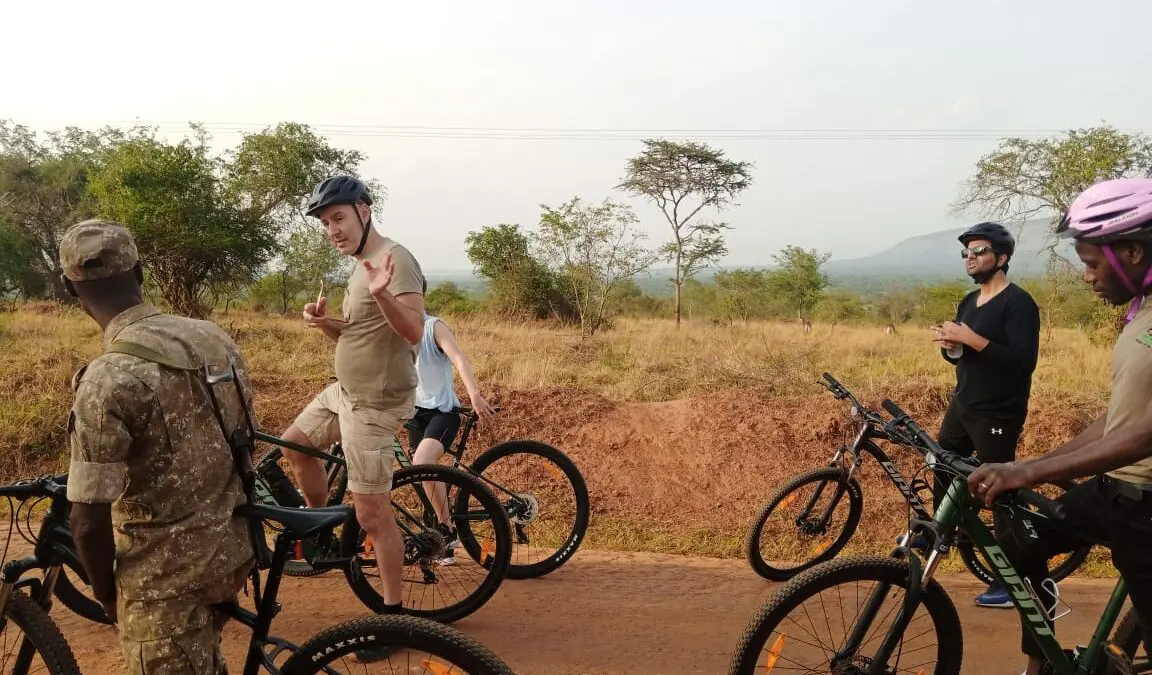Cycling in Lake Mburo national park.
Cycling in Lake Mburo national park is a unique and then exciting way to experience the Uganda’s wildlife up close. Unlike traditional safaris where you stay in a vehicle, cycling allows you to feel the fresh air and immerse yourself in the natural surroundings. Its an activity that provides a different perspective on the park’s animals and landscapes, offering a more personal and active adventure.

What makes cycling in Lake Mburo National Park unique.
Lake Mburo National Park is one of the few places in Uganda where you can go on a safari on foot or on a bike. This is possible because the park does not have dangerous predators like lions and then leopards, which are common in other parks like Queen Elizabeth national park or Murchison falls national park. Instead, the park is a home to a rich population of herbivorous animals and a few smaller carnivores that are not a threat to cyclists. This makes it a safe environment for you to get out of the car and then explore the savannah. The experience of cycling past zebras, impalas, and giraffes and among others is a truly unforgettable. It’s a chance to hear the sounds of the bush, smell and wild sage, and feel connected to the environment in a way a car cannot provide.
Cycling experience and the animals you will see.
Cycling route in Lake Mburo national park is well-maintained network of trails and dirt roads that take you through various parts of the park. The duration of the cycling trip can vary, from a short two-hour ride to a longer, more challenging half-day adventure. A ranger from Uganda Wildlife Authority will always accompany you to ensure your safety and point out interesting animals and plants.
As you cycle, you will encounter a great variety of animals. The most common and then famous resident of the park is the plains zebra. You will see large herds of them grazing peacefully near the road. The park also has the largest population of impalas in Uganda, which are elegant and very fast antelopes. Look out for the beautiful Rothschild’s giraffes, which have been successfully reintroduced into the park. You will likely to see them stretching their long necks to eat from the acacia trees. Other animals you can expect to see include topis, which are easily identified by their reddish-brown coats and then long faces and the shy elands, Africa’s largest antelope. In the wetlands and near the lakes, you might spot hippos and then huge Nile crocodiles, but from a safe distance. The park is also a birdwatcher’s paradise, so keep an eye out for the colorful birds like the kingfishers and rollers and among others.
Preparing for your cycling safari.
To make your cycling safari in Lake Mburo national park as enjoyable as possible, a little preparation is key. Firstly, you will need a bicycle; that is most lodges and tour operators like Nyumbu Beyond Journeys in the park offer bicycle for renting, which are usually well-maintained mountain bikes. You are advised to check the bike’s condition and fit before you start. Its essential to wear a helmet, which is usually provided. Dressing in comfortable, light clothing is the best thing to do. Since it can get hot during the day, wearing a hat is recommended. Do not forget to bring sunscreen and insect repellent. You should also carry plenty of water to stay hydrated, as cycling in the African sun can be tiring and exhausting. Your guide will give you a safety briefing and advise you on the best route for your fitness level.

A different way to experience a safari.
While it can seem as an easy one, cycling in Lake Mburo national park is a fantastic alternative to a game drive. It gives you best time to move at your pace and stop whenever you want to take a picture or simply admire a view. It’s a quiet way to explore the park, as the ranger can brief you about the tracks to spot animals. It’s a great activity for families and for anyone looking to add a bit of exercise and adventure to their safari holiday with unforgettable safari memories.
In conclusion, cycling in Lake Mburo national park is a wonderful safari activity for anyone visiting Uganda. It provides a rare opportunity to get up close and personal with wildlife in a safe, and active way. It’s a unique safari experience that offers a fresh perspective on the beauty of the African bush and is sure to be one of highlights of your safari.

